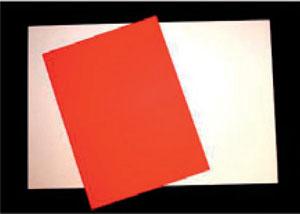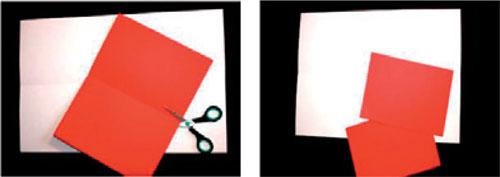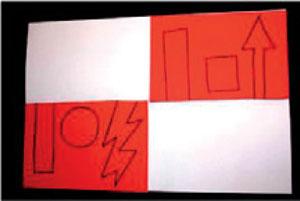Create To Communicate
Create To Communicate
LESSON 2
SPACE
Reflecting Patterns
Objective: Students will write a Diamante poem using nouns, adjectives, and present participles to illustrate two opposing views, themes, or subjects.
Level: Intermediate to Advanced
Materials: Paper of two contrasting colors, scissors, pencils, glue, paste, or glue sticks.
Teacher Preparation: If needed for younger learners, cut pieces of colored paper ahead of time for students to use to create their reflected patterns collages.
INSTRUCTIONS
Part One: Opposites Warm-Up Activity
- This activity deals with opposite or contrasting ideas. Play an opposites game to warm students up. Two opposite game options are listed below.
a. Opposite Crossword Puzzle: Make a crossword puzzle online with the puzzle maker resource listed below. Create crossword prompts such as “The opposite of…” Example prompts are listed below. Students will have to write the answers for the crossword prompts in the crossword puzzle. Students can work on the puzzle individually or in pairs.Example Prompts:
The opposite of sunny The opposite of dry The opposite of rich The opposite of clean The opposite of fast The opposite of happy Discovery Education Crossword Puzzle Maker: http://puzzlemaker.discoveryeducation.com/CrissCrossSetupForm.aspb. Opposite Flash Cards: Write words with clear opposites on flash cards. Make several sets so that students can work in groups. Give each group a set of flash cards. Time this activity. When you say “go,” tell students to turn over one flash card at a time. Groups then have to write down the opposite of what is written on each card. When you say “stop,” the group that wrote the most (correct) opposites wins. Flash card words might include strong, light, cold, big, short, skinny, noisy, clean, good, high, empty, and sad.
Part Two: Reflected Patterns Collage
- Show students the example at the beginning of the activity of a reflected patterns collage.
- Tell students they will be creating their own reflected patterns collage.
- Pass out materials. Each student will need one large sheet of paper for the base, and a smaller rectangle of contrasting colored paper. The base sheet of paper should be twice the size of the smaller piece of paper.

- Explain and demonstrate the steps below:
a. Fold the bigger piece of paper in half, lengthwise. If needed, draw a light line down the fold with a pencil. After the paper is folded, unfold it. The crease that the fold creates should be used as a guideline or marker of the center of the paper.b. Take the smaller piece of paper and fold it in half. Cut the rectangle in half along the fold, as in the pictures below.
 c. Draw shapes on the two pieces of colored paper. The shapes should touch, or come close to, one edge of the paper, as in the picture to the right.
c. Draw shapes on the two pieces of colored paper. The shapes should touch, or come close to, one edge of the paper, as in the picture to the right. d. Cut the shapes out.e. Line up the colored pieces of paper with the shapes cut out with the center fold of the larger base paper. The two pieces of paper should be diagonal from one another, as shown on the right. Glue the colored rectangle to the base paper once the shapes are cut out.f. Arrange the cut-out shapes so that they lie opposite and reflect the spaces that they were cut out from.g. When the shapes are arranged correctly, glue the shapes to the paper.h. The finished product should be a reflected patterns collage.
d. Cut the shapes out.e. Line up the colored pieces of paper with the shapes cut out with the center fold of the larger base paper. The two pieces of paper should be diagonal from one another, as shown on the right. Glue the colored rectangle to the base paper once the shapes are cut out.f. Arrange the cut-out shapes so that they lie opposite and reflect the spaces that they were cut out from.g. When the shapes are arranged correctly, glue the shapes to the paper.h. The finished product should be a reflected patterns collage. *NOTE: This activity can be made more detailed for older learners. To do so, students can use one large square of paper and cut out detailed and intricate designs from each side of the square. Students then reflect the cut-out shapes over each of the four sides of the square.
*NOTE: This activity can be made more detailed for older learners. To do so, students can use one large square of paper and cut out detailed and intricate designs from each side of the square. Students then reflect the cut-out shapes over each of the four sides of the square.
Part Three: Reflected Patterns Collage Listening Activity
- Once students are familiar with the format of the reflected patterns collage, repeat the activity again, but this time as a listening activity.
- Have students work with one or two partners. Have the pairs or small groups create another small reflected patterns collage and write the directions for making their collage. Students should emphasize the imperative form of the verbs used; for example: cut out a square or fold the paper in half.
- Students will then take turns giving their directions to the class. The rest of the class must follow the directions they hear to create another small reflected patterns collage. At the end, compare the collages students created with the group’s collage. To save time and allow every group to give their directions, students can use only one small sheet of paper instead of two. Another variation is that students could give their directions to one other group instead of the whole class.
Part Four: Diamante Poem
- Once students have completed their reflected patterns collages, have them write a Diamante poem. Diamante poems are diamond-shaped poems that involve two opposing ideas or topics. Students can use either the two different colors represented in their collage as the two topics of the poem, or whatever two opposing ideas you instruct students to use. Examples of other topics might include night and day, summer and winter, city and countryside, or chocolate and vanilla.
- Students will have to come up with contrasting nouns, adjectives, and present participles for their Diamante poems. If needed, allow students to use dictionaries or thesauruses.
- Have students follow the Diamante pattern listed on the next page to create their poem. Write the pattern on the board for students to refer to.
- (Optional) Create an example of a Diamante poem with the class to help the students see and understand the format of the poem.
- When students are finished writing their poems, have students share their poems with the class. Make a list of the contrasting nouns used in the poems; explain any unclear meanings or relationships to students.
- (Optional) If students write their Diamante poem about the two colors they used in their reflected patterns collage, display the collage, along with the Diamante poems, in the classroom or school.
Diamante Poem Pattern
Line 1: One noun
Line 2: Two adjectives related to the first noun
Line 3: Three participles related to the first noun (-ing words)
Line 4: Four nouns, two related to the first noun
and two related to the second noun (in Line 7)
and two related to the second noun (in Line 7)
Line 5: Three participles related to the second noun (-ing words)
Line 6: Two adjectives related to the second noun
Line 7: One noun — the opposite of the noun in Line 1
*Adapted from “Diamante” poem, p. 94, Writing Simple Poems, by Vicki L. Holmes and Margaret R. Moulton
Example Diamante Poem
Black
Mysterious, Dim
Searching, Covering, Warning
Darkness, Shadows — Daylight, Warmth
Blinding, Shining, Dazzling
Pure, Light
White
Part Five: “I have… Who has…?” Closing Activity
- Reinforce the contrasting nouns used in the poem by playing the “I Have… Who Has…?” game.
- Write the contrasting nouns used in students’ poems on notecards, one per card.
- Give each student a card. Students must find the students in the classroom that have the contrasting noun to the noun on their card.
- In order to play this game, students must first identify what nouns are opposite of what is written on their card. Then, they must circulate around the room, telling and asking students, “I have… Who has/Do you have…?” For example, if a student has the word “summer” written on their card, he or she should say to other students, “I have summer. Who has/Do you have winter?”
- For large classes, this game can also be played with groups. Give each group a set of cards, with equal numbers of contrasting nouns. Each group member gets one card. Group members must then work together to find the group member with the opposite noun on his or her card by asking, “I have… Who has…?” The first group to find all the matches wins.
Extension Activity:
Abstract Diamante
For more advanced students, have them write an additional Diamante poem about more abstract or philosophical subjects. For example, opposing topics for the poem could be love and hate, peace and war, or wealth and poverty.